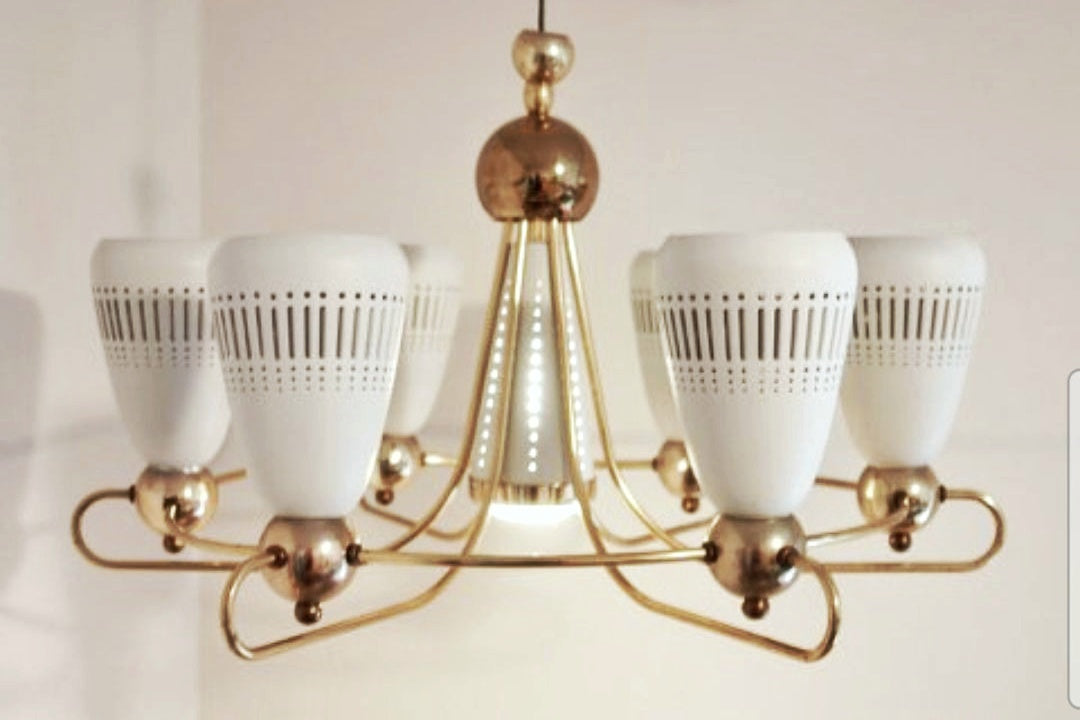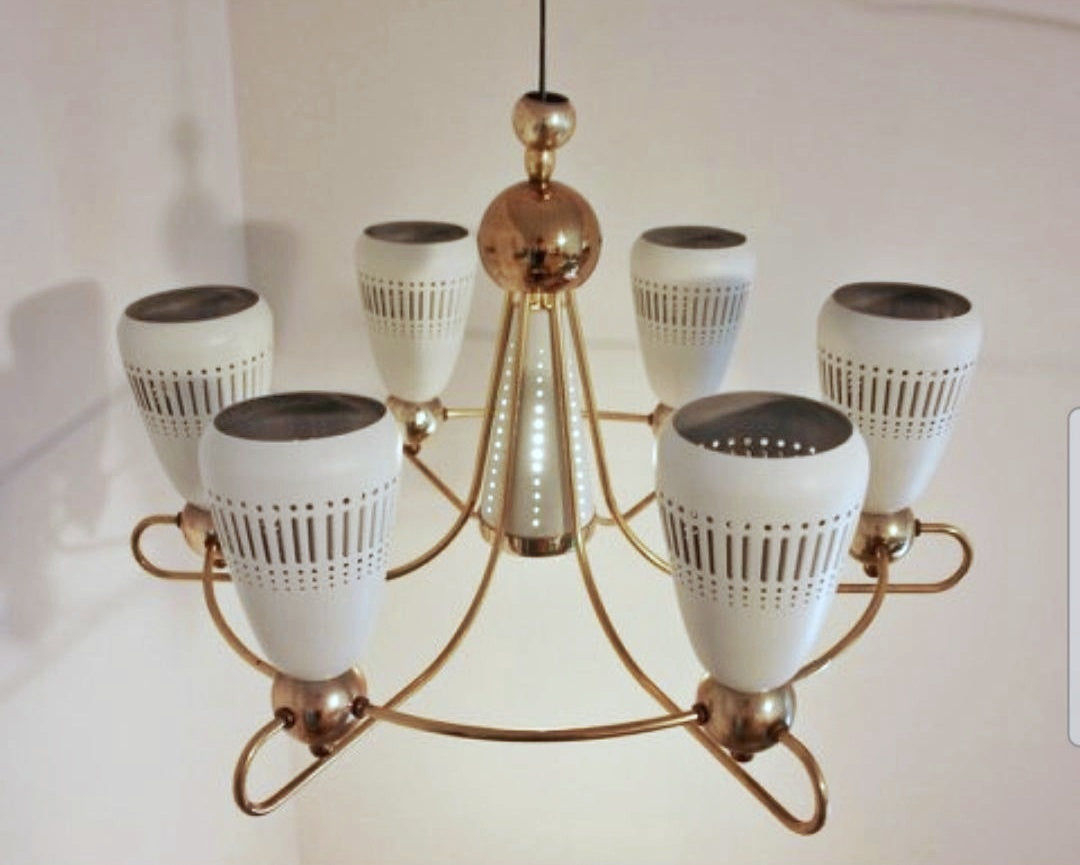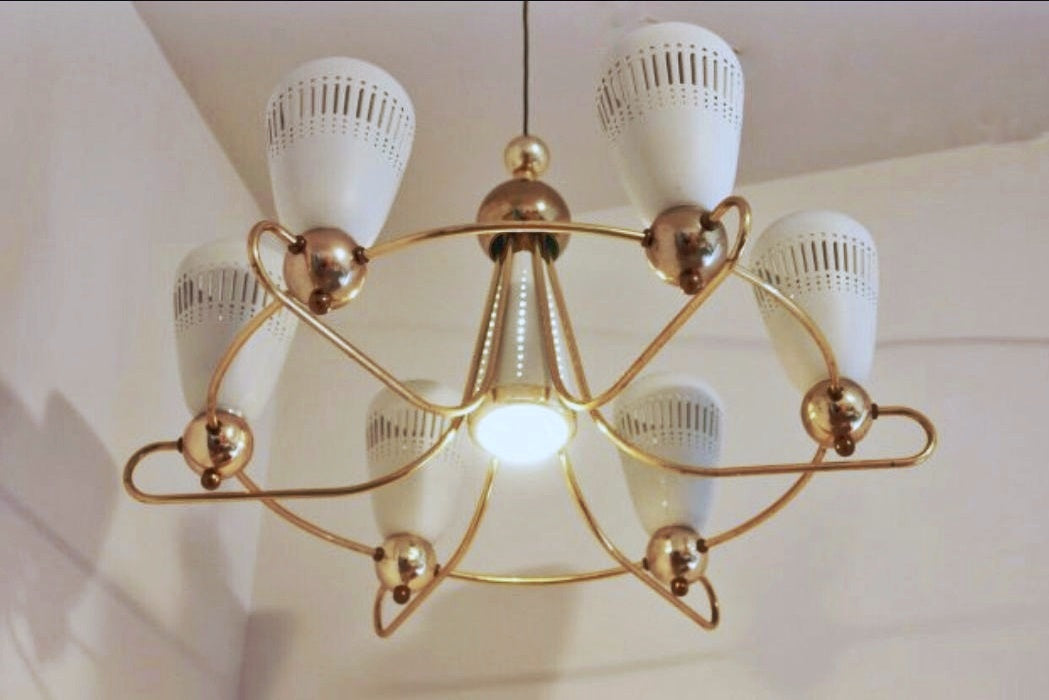


6-ARM BRASS CHANDELIER ATTRIB. TO PAAVO TYNELL
CONTACT US HERE ABOUT THIS ITEM.
A stylish, six-arm, brass chandelier with white, perforated metal diffusers and a central downlight. Produced in Canada, probably in the '50s, and attributed to the great Finnish lighting designer Paavo Tynell.
PAAVO VILJO TYNELL (1890–1973) was a Finnish industrial designer whose pioneering work in the first half of the 20th century had a lasting influence on international lighting design. He was born in Helsinki, 12 years after the invention of the domestic lightbulb, at a time when Finland, like most of northern Europe, was yet to be electrified. The seventh of nine children in a working-class family (who could not afford an education for their son beyond primary school), Tynell entered an apprenticeship at G.M. Sohlberg’s metalsmith workshop when he was 16, spending six years as a sheet metal worker and another as a blacksmith, before beginning formal studies at the University of Art and Design Helsinki. His final university project was a light fixture in brass—a material that would later become his trademark. Arguably, the deferral of his secondary education positioned Tynell perfectly to join the vanguard of modern lighting design upon graduation.
In 1918 Tynell co-founded the metalwork and lighting company Oy Taito AB (named after the Finnish word for "skill"). As managing director of the company’s foundry, he oversaw the production of a range of light fittings and other functional objects—as well as sculptures and large-scale custom pieces. Tynell also served as the firm’s principal designer throughout the '20s, supported by a roster of other Finnish artists that included graphic designer and decorative painter Henry Ericsson (1898–1933) and sculptor Ville Vallgren (1855–1940).
By the 1930s, Oy Taito was exclusively a lighting company, having leaned into the growing electrification of a newly independent Finland. Its small shop became a factory and soon employed over a hundred people. Taito earned a reputation as an industry trendsetter, and Tynell’s international reputation grew in parallel—largely thanks to high-profile lighting projects such as Parliament House in Helsinki, designed by architect Johan Sigfrid Sirén (1889-1961), and collaborations with leading modernist architects, notably Alvar Aalto (1898–1976). Working to incorporate artificial lighting into modern environments, Taito produced fixtures for all of Aalto’s major projects including the Paimio Sanatorium and the Viipuri Library. The collaboration proved fruitful, and it earned Tynell the epithet "the man who illuminated Finland." His talent for creating indirect light was especially sought after in spaces such as restaurants and movie theaters, where softer, more atmospheric lighting was naturally prized.
Tynell’s influence outside of his native country was bolstered by an association with the Finland House of New York City, a design atelier that showcased the work of Finnish designers and craftspeople. He was entrusted with prestigious orders for American public buildings, such as the UN Secretary-General’s office, and for important private homes. Model 9060, a beautiful bowl-like lamp in pattern-perforated brass, whose design earned first prize at the American Institute of Interior Decorators' annual competition, emerged from the former undertaking.
The '30s and '40s were largely a time of experimentation for Tynell, whose style evolved from the functionalist and art deco designs of his early career into more decorative and elegant expressions. Throughout this period, he served as chairman of Ornamo, an association of Finnish industrial designers, and, through Taito, he provided training and support for the up-and-coming, often enlisting them as drafting assistants, to jumpstart their careers. One such assistant, the glass designer Helena Turpeinen (1918–2016), married Tynell in 1947.
Following WWII, Paavo Tynell had begun to design using brass, the only metal immediately accessible in Finland as it was a genuinely domestic product, owing to the Outokumpu copper mines. Brass fixtures were an instant success in North America, and Tynell began creating designs for the prestigious American company Lightolier; this productive partnership lasted until 1966. Marked by delicacy and softness, the collaboration's most famous forms echo the structures of nature.
Tynell’s distinctive style, coupled with his understanding of light’s role in shaping an atmosphere, proved to have a timeless appeal. Today his lamps are highly sought after by an international clientele of collectors, and prices of more important pieces have soared at auction. His lighting is part of the urban fabric of Helsinki, and many of his grand installations survive today—in buildings ranging from train stations and churches to hotels and educational institutions, not to mention the famous Lasipalatsi (Ice Palace) office building.
The merger of Taito with the lighting factory Idman Oy in 1953 prompted Tynell’s retirement as managing director of the company, but he continued designing for Taito on a freelance basis and for other lighting brands in Finland and abroad. During his career, Tynell won prizes at the 1929 Barcelona World Fair and the 1933 Milan Triennale and, in 1951, received the Chicago Athenaeum's Good Design Award for lighting.
DETAILS
Designer – PAAVO TYNELL (ATTRIB.)
Design Period/Year – 1940s
Maker – UNKNOWN
Production Period/Year – 1950s
Origin – CANADA
Styles/Movements – MODERN; ART DECO
Materials – BRASS, METAL
Colors – WHITE, BRASS
Shade – DIFFUSERS
Power – UP TO 120V (US STANDARD), HARDWIRED
Condition – Very good vintage condition; without defects, but showing slight traces of use.
Dimensions – 21" DIAM. × 13" H



